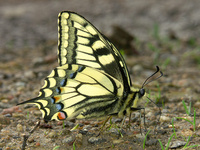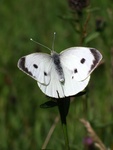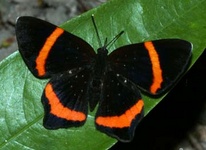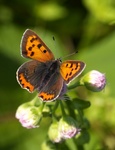Papilionoidea
True Butterflies
Andrew V. Z. Brower


This tree diagram shows the relationships between several groups of organisms.
The root of the current tree connects the organisms featured in this tree to their containing group and the rest of the Tree of Life. The basal branching point in the tree represents the ancestor of the other groups in the tree. This ancestor diversified over time into several descendent subgroups, which are represented as internal nodes and terminal taxa to the right.

You can click on the root to travel down the Tree of Life all the way to the root of all Life, and you can click on the names of descendent subgroups to travel up the Tree of Life all the way to individual species.
For more information on ToL tree formatting, please see Interpreting the Tree or Classification. To learn more about phylogenetic trees, please visit our Phylogenetic Biology pages.
close boxIntroduction
The "true" butterflies are composed of five families - Papilionidae, Pieridae, Nymphalidae, Riodinidae and Lycaenidae. There are estimated to be some 13,700 species extant in the world (Robbins, 1982), distributed on every continent except Antarctica, and most remote oceanic islands as well. The greatest diversity occurs in tropical regions, particularly the neotropics.
Characteristics
Butterflies are commonly distinguished from "moths" (an enormous paraphyletic group of which butterflies represent a derived subclade) by their diurnal activity and their clubbed antennae. In general, most day-flying Lepidoptera are butterflies, but there are some crepuscular butterfly species that are rarely encountered during the daytime, and there are also many species of moths that are active during the day (e. g., Uraniidae, Zygaenidae, Castniidae, some Arctiidae and Sphingidae). In addition, it should be noted that some moth groups, such as Castniidae and Zygaenidae, also exhibit clubbed antennae!
Discussion of Phylogenetic Relationships
The hypothesis of relationships presented here, based on a combination of morphological and DNA characters, has been repeatedly corroborated by numerous authors (Kristensen 1976, de Jong et al. 1996, Ackery et al. 1999, Wahlberg et al. 2005).
References
Ackery, P. R., R. de Jong, and R. I. Vane-Wright. 1999. The butterflies: Hedyloidea, Hesperioidea, and Papilionoidea. Pages 264-300 in: Lepidoptera: Moths and Butterflies. 1. Evolution, Systematics, and Biogeography. Handbook of Zoology Vol. IV, Part 35. N. P. Kristensen, ed. De Gruyter, Berlin and New York.
Boggs, C. L., W. B. Watt, and P. R. Ehrlich, eds. 2003. Butterflies: Ecology and Evolution Taking Flight. University of Chicago Press, Chicago and London.
Campbell, D. L., A. V. Z. Brower, and N. E. Pierce. 2000. Molecular evolution of the wingless gene and its implications for the phylogenetic placement of the butterfly family Riodinidae (Lepidoptera: Papilionoidea). Molecular Biology and Evolution 17(5):684-696.
de Jong, R., R. I. Vane-Wright, and P. R. Ackery. 1996. The higher classification of butterflies (Lepidoptera): problems and prospects. Entomologica Scandinavica 27(1):65-101.
Kristensen N. P. 1976. Remarks on the family-level phylogeny of butterflies (Insecta, Lepidoptera, Rhopalocera). Zeit. Zool. Syst. Evol. 14: 25-33.
Kristensen, N. P. and A. W. Skalski. 1999. Phylogeny and paleontology. Pages 7-25 in: Lepidoptera: Moths and Butterflies. 1. Evolution, Systematics, and Biogeography. Handbook of Zoology Vol. IV, Part 35. N. P. Kristensen, ed. De Gruyter, Berlin and New York.
Minet, J. 1991. Tentative Reconstruction of the ditrysian phylogeny (Lepidiptera, Gloassata). Entomologica Scandinavica 22(1):69-95.
Paulus, H. F., and H. W. Krenn. 1996. Comparative morphology of the butterfly proboscis and its sensilla - A contribution to the phylogenetic systematics of Papilionoidea (Insecta, Lepidoptera). Journal of Zoological Systematics and Evolutionary Research 34(4):203-216.
Robbins R. K. 1982. How many butterfly species? News Lepid. Soc. 1982: 40-41.
Wahlberg, N., M. F. Braby, A. V. Z. Brower, R. de Jong, M.-M. Lee, S. Nylin, N. E. Pierce, F. A. H. Sperling, R. Vila, A. D. Warren, and E. Zakharov. 2005. Synergistic effects of combining morphological and molecular data in resolving the phylogeny of butterflies and skippers. Proceedings of the Royal Society Series B 272:1577-1586.
Weller, S. J. and D. P. Pashley. 1995. In seach of butterfly origins. Molecular Phylogenetics and Evolution 4(3):235-246.
Information on the Internet
- LepIndex. The Global Lepidoptera Names Index. Natural History Museum, London.
- Butterflies & Moths of the World: Generic Names & their Type-species. Brian Pitkin and Paul Jenkins. Natural History Museum, London.
- HOSTS - a Database of the World's Lepidopteran Hostplants
- Butterflies of America. An interactive listing of American butterflies.
- The Butterfly Conservatory. Movie clips and live butterfly web cam. American Museum of Natural History, New York.
- Butterflies at the Field Museum. The Field Museum, Chicago.
- The Butterfly Conservatory. Movie clips and live butterfly web cam. American Museum of Natural History, New York.
- Butterflies and Moths of North America. Occurrence maps, species accounts, checklists, and photographs.
- FieldGuides: Butterflies. enature.com
- BugGuide.Net: Superfamily Papilionoidea - Butterflies. Identification, Images, & Information For Insects, Spiders & Their Kin For the United States & Canada.
- Butterflies and their Larval Foodplants
- Butterflies of Canada
- Michigan Lepidoptera Survey
- Butterflies of Southeastern Arizona. Bruce Walsh, University of Arizona.
- Art Shapiro's Butterfly Site
- Butterflies and Their Larval Foodplants. Information on Orange County butterflies and moths.
- North American Butterfly Association (NABA). A membership-based not-for-profit organization working to increase public enjoyment and conservation of butterflies.
- Association for Tropical Lepidoptera
- Neotropical Butterflies. A Photo Gallery featuring butterflies from Mexico through Central America to Amazonia and Argentina.
- Butterflies of Ecuador. Systematics - Biogeography - Natural history. Keith R. Willmott, Jason P.W. Hall.
- Mariposas Mexicanas: Interactive Listing of Mexican Butterflies. Warren, A. D., J. E. Llorente-Bousquets, A. Luis-Martínez & I. Vargas-Fernández.
- Tropical Andean Butterfly Diversity Project.
- Catalogue of the Lepidoptera of the French Antilles.
- Afrotropical Butterflies. Mark C. Williams.
- Moths and Butterflies of Europe and North Africa
- European Butterflies.
- European Butterflies.
- Lepidoptera and some other life forms
- Butterfly Conservation. Protecting wild butterflies and their habitats in the UK.
- Butterflies of Ireland
- Butterflies and Moths of the Netherlands
- Colour Atlas of the Siberian Lepidoptera
- Butterfly Larvae of Australia.
- South Australian Butterflies.
- A Check List of Butterflies in Indo-China. Chiefly from Thailand, Laos, and Vietnam.
- Butterflies and Dragonflies of Sri Lanka
- Singapore Butterfly Checklist
- Photographs from Nature - Butterfly Gallery.
- The Beautiful World of Butterflies.
- The Butterfly WebSite
- Electronic Resources on Lepidoptera
- Where do butterflies come from?. An activity for children. Howard Hughes Medical Institute.
Title Illustrations

The five butterflies shown here represent the type species of the five butterfly families: Papilio machaon, Pieris brassicae, Riodina lysippus, Lycaena phlaeas and Nymphalis polychloros. All of these species were described by Linnaeus (1758).
| Scientific Name | Papilio machaon |
|---|---|
| Location | Czech Republic: Blansko |
| Comments | type species of Papilionoidea |
| Creator | Michal Koup´y |
| Specimen Condition | Live Specimen |
| Identified By | Michal Koup´y |
| Behavior | puddling |
| Sex | Male |
| Life Cycle Stage | adult |
| View | ventral |
| Source | Old World Swallowtail Papilio Machaon |
| Source Collection | BioLib.cz |
| Scientific Name | Pieris brassicae |
|---|---|
| Location | near Fountains Abbey, Yorkshire, England |
| Specimen Condition | Live Specimen |
| Source | White Butterfly |
| Source Collection | Flickr |
| Image Use |
 This media file is licensed under the Creative Commons Attribution-NoDerivs License - Version 2.0. This media file is licensed under the Creative Commons Attribution-NoDerivs License - Version 2.0.
|
| Copyright | © 2005 Paul Stevenson |
| Scientific Name | Riodina lysippus |
|---|---|
| Location | Brazil: Mato Grosso, Cristalino Lodge |
| Comments | Type species of Riodinidae |
| Specimen Condition | Live Specimen |
| Identified By | Gill Carter |
| Sex | Male |
| Life Cycle Stage | adult |
| View | dorsal |
| Source | Lysippus Metalmark (Riodina lysippus) |
| Source Collection | Neotropical Butterflies |
| Copyright | © 2006 Gill Carter |
| Scientific Name | Lycaena phlaeas |
|---|---|
| Location | Iwate, Japan |
| Specimen Condition | Live Specimen |
| Source | Small Copper - ベニシジミ |
| Source Collection | Flickr |
| Image Use |
 This media file is licensed under the Creative Commons Attribution-NonCommercial-NoDerivs License - Version 2.0. This media file is licensed under the Creative Commons Attribution-NonCommercial-NoDerivs License - Version 2.0.
|
| Copyright | © 2006 Bruce the Moose |
| Scientific Name | Nymphalis polychloros |
|---|---|
| Location | Czech Republic: Blansko |
| Comments | Type species of Nymphalidae |
| Creator | Michal Koup´y |
| Specimen Condition | Live Specimen |
| Identified By | Michal Koup´y |
| Sex | Male |
| Life Cycle Stage | adult |
| View | dorsal |
| Source | Large Tortoiseshell (Nymphalis polychloros) |
| Source Collection | BioLib.cz |
About This Page

Middle Tennessee State University, Murfreesboro, Tennessee, USA
Correspondence regarding this page should be directed to Andrew V. Z. Brower at
Page copyright © 2010
 Page: Tree of Life
Papilionoidea . True Butterflies.
Authored by
Andrew V. Z. Brower.
The TEXT of this page is licensed under the
Creative Commons Attribution License - Version 3.0. Note that images and other media
featured on this page are each governed by their own license, and they may or may not be available
for reuse. Click on an image or a media link to access the media data window, which provides the
relevant licensing information. For the general terms and conditions of ToL material reuse and
redistribution, please see the Tree of Life Copyright
Policies.
Page: Tree of Life
Papilionoidea . True Butterflies.
Authored by
Andrew V. Z. Brower.
The TEXT of this page is licensed under the
Creative Commons Attribution License - Version 3.0. Note that images and other media
featured on this page are each governed by their own license, and they may or may not be available
for reuse. Click on an image or a media link to access the media data window, which provides the
relevant licensing information. For the general terms and conditions of ToL material reuse and
redistribution, please see the Tree of Life Copyright
Policies.
- Content changed 07 October 2008
Citing this page:
Brower, Andrew V. Z. 2008. Papilionoidea . True Butterflies. Version 07 October 2008 (under construction). http://tolweb.org/Papilionoidea/12027/2008.10.07 in The Tree of Life Web Project, http://tolweb.org/















 Go to quick links
Go to quick search
Go to navigation for this section of the ToL site
Go to detailed links for the ToL site
Go to quick links
Go to quick search
Go to navigation for this section of the ToL site
Go to detailed links for the ToL site